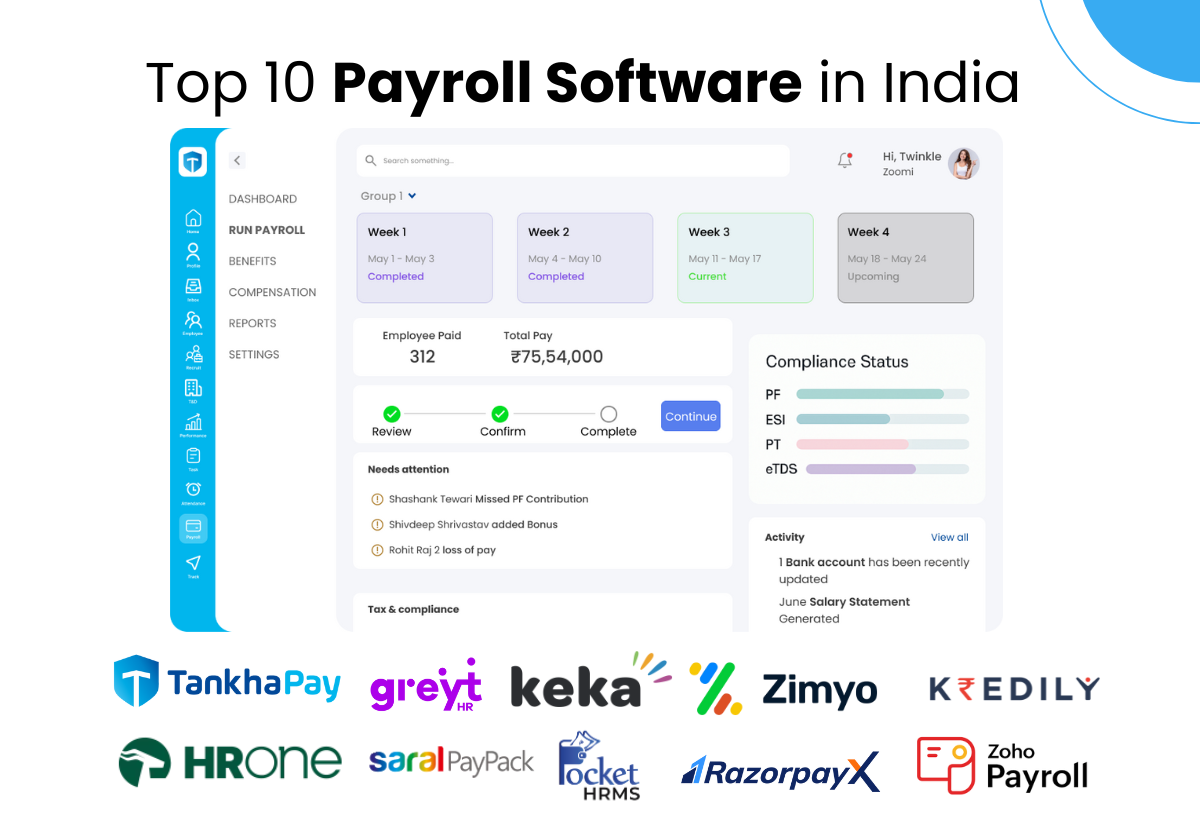In India’s dynamic business environment, managing payroll is a complex task fraught with challenges like intricate tax laws, diverse labor regulations, and the risk of human error. Picture an HR team drowning in spreadsheets, manually computing salaries, deductions, and statutory contributions—a process ripe for mistakes that could lead to penalties or unhappy employees. Payroll software in India has emerged as a game-changer, automating these tasks to deliver accuracy, speed, and compliance.
As of October 2025, with India’s workforce surpassing 500 million and the HR tech market projected to hit $18.9 billion by 2032, automating payroll is no longer optional—it’s essential. This 2000-word guide explores the transformative power of payroll software in India, covering its benefits, must-have features, compliance requirements, top solutions, implementation steps, and real-world success stories. Whether you’re a startup in Hyderabad or an enterprise in Delhi, this guide will help you harness payroll automation to save time, reduce costs, and focus on growth.
The Payroll Puzzle in India: Why Automation is Critical
India’s payroll landscape is a maze of regulations, from the Employees’ Provident Fund (EPF) under the 1952 Act to Employee State Insurance (ESI) and Tax Deducted at Source (TDS) under the Income Tax Act, 1961. Add state-specific Professional Tax (PT) slabs and gratuity obligations under the Payment of Gratuity Act, 1972, and manual processing becomes a nightmare. Non-compliance risks hefty fines—up to ₹1 lakh per violation—while errors in calculations can erode employee trust.
Manual payroll, often managed via Excel, takes 10-15 days per cycle for mid-sized firms, with error rates of 5-10%. Late salary payments frustrate workers, and the four Labour Codes (fully enforced by 2025) demand digital compliance, increasing scrutiny from EPFO and ESIC. State-specific Shops and Establishments Acts further complicate multi-location operations.
Payroll software in India tackles these challenges head-on. By automating calculations, filings, and integrations, it cuts processing time to hours, reduces errors by 90%, and ensures full compliance. A 2025 Deloitte study notes that businesses adopting payroll automation achieve a 300% ROI within 12 months, driven by time savings and penalty avoidance.
Why Automate Payroll? Key Benefits for Indian Businesses
Payroll automation delivers transformative advantages for organizations of all sizes:
- Time and Efficiency Gains: Manual payroll involves cross-checking attendance, leave, and overtime data. Automation syncs with HR systems, enabling instant calculations. Tools like RazorpayX process bulk salaries in minutes, freeing HR for strategic priorities. Companies report up to 70% faster payroll cycles.
- Error-Free Accuracy: Missteps in TDS, PF, or ESI calculations can lead to costly corrections. Automated systems align with Indian laws, ensuring precise salary breakdowns. A 2025 PwC report found that automation reduces errors by 95%, minimizing financial losses.
- Compliance Made Simple: With Labour Codes mandating digital filings, payroll software auto-generates TDS returns (Form 24Q), PF challans, and ESI reports. It tracks deadlines for PT (₹200-₹2,500 annually by state) and ESI (0.75% employee + 3.25% employer), avoiding penalties that rose 20% in 2025.
- Cost Savings: Manual or outsourced payroll incurs hidden expenses—training, audits, and fines. Cloud-based tools cost ₹25-₹100 per employee/month, delivering 40-50% savings. Scalable pricing suits growing businesses without hardware investments.
- Employee Empowerment and Security: Self-service portals allow employees to access payslips, tax forms, and leave data via mobile apps, cutting HR queries by 60%. Robust encryption (ISO 27001 compliant) aligns with India’s DPDP Act 2023, protecting sensitive information.
- Scalability and Insights: With India’s SME sector growing 15% in 2025, payroll software scales seamlessly. Analytics on payroll costs, compliance gaps, and turnover trends drive smarter decisions.
Payroll software in India is a strategic tool, transforming compliance burdens into opportunities for efficiency and growth.
Essential Features of Payroll Software for India
Choosing the right payroll software requires a focus on features tailored to India’s unique needs:
- Automated Salary Processing: Handles basic pay, HRA, allowances, overtime, bonuses, and arrears. Supports direct bank transfers via NEFT/RTGS/IMPS.
- Compliance Automation: Manages PF (12% each), ESI, TDS (5-30% slabs), PT, and gratuity (15 days’ salary/year after 5 years). Must integrate with EPFO/ESIC portals for 2025 filings.
- Employee Self-Service Portal: Provides mobile/web access to payslips, Form 16, and investment declarations. SMS/email alerts enhance transparency.
- Integration and Flexibility: Syncs with HRMS (e.g., biometric attendance), accounting (Tally/Zoho Books), and ERP systems. Custom pay components for loans or incentives are key.
- Analytics and Reporting: Offers dashboards for payroll audits, cost forecasts, and compliance reports, exportable for ITR filings.
- Security and Scalability: Features role-based access, audit logs, and cloud hosting for remote teams. Multi-state PT/ESI support is critical.
- Support and Setup: Includes 24/7 assistance and user-friendly onboarding wizards.
Advanced options like AI-driven error detection and multi-currency support cater to global firms.
Leading Payroll Software in India for 2025
India’s payroll market offers diverse solutions. Based on 2025 G2 and Gartner insights, here’s a snapshot of top players:
| Software | Ideal For | Key Features | Pricing (per employee/month) | Pros | Cons |
|---|---|---|---|---|---|
| Tankhapay | Startups & SMEs | Auto TDS/PF/ESI, ESS portal, 100+ integrations | ₹50-₹100 | Intuitive, quick setup | Limited deep analytics |
| Zoho Payroll | Small Firms | Free for <10 users, tax automation, Zoho Books sync | ₹40+ | Budget-friendly, flexible | Basic reporting |
| RazorpayX Payroll | Tech-Savvy Businesses | Bulk payments, compliance alerts, WhatsApp integration | ₹100+ | Fast disbursals, 45+ integrations | Costlier for small teams |
| GreytHR | Mid-Sized Firms | Full HR suite, retro processing, audit reports | ₹30-₹80 | Strong compliance, trusted | Complex for beginners |
| PeopleStrong | Enterprises | AI-driven, multi-state PT, end-to-end HR | Custom (₹150+) | Scalable, auto-filings | High cost |
| factoHR | Compliance-Driven | Wizard-guided, arrears calc, ISO security | ₹25-₹75 | Accurate, mobile-friendly | Fewer global features |
| Zimyo | Growing Businesses | Unlimited pay heads, loan calc, trusted by Toyota | ₹20-₹60 | Affordable, simple | Limited customization |
| HRMantra | Complex Pay Structures | Formula-based pays, bonus/loan mgmt | ₹50-₹120 | Enterprise-grade | Outdated on-premise options |
| Deel | Global/Remote Teams | 150+ countries, India compliance, EOR | ₹500+ (flat) | Remote-focused | Expensive for local firms |
| Asanify | SMEs | AI automation, one-click filings | ₹40-₹90 | Easy setup, accurate | Newer player |
Select based on scale: Zoho for small teams, GreytHR for mid-sized firms.
Mastering Compliance: Key Regulations in 2025
Compliance is non-negotiable. Critical laws include:
- EPF Act, 1952: 12% contribution each; ₹15,000/month threshold. Software automates ECR filings.
- ESI Act, 1948: Applies to wages <₹21,000; 0.75% employee + 3.25% employer. Monthly filings required.
- Income Tax Act, 1961: TDS per new regime slabs (0-30%). Form 16 due by June 15.
- Gratuity Act, 1972: 15 days’ pay/year post-5 years; ₹20 lakh cap.
- Minimum Wages & Payment of Wages Acts: State-specific minima (e.g., ₹15,000 Delhi); salaries due within 7-10 days.
The 2025 Labour Codes consolidate these, emphasizing digital records and gig worker coverage. Software with auto-updates ensures compliance, avoiding 20% higher fines.
How to Implement Payroll Software: A Step-by-Step Plan
Deploying payroll software is straightforward with this roadmap:
- Evaluate Needs (1-2 Weeks): Review current processes, workforce size, and pain points (e.g., multi-state compliance). List must-have features.
- Choose a Vendor (1 Week): Test 3-5 tools via demos; check reviews. Run a pilot with a small employee group.
- Data Setup & Migration (2-4 Weeks): Import employee data (PAN, bank details) via Excel. Set up pay structures and compliance rules.
- Integration & Validation (1-2 Weeks): Connect with HR/ERP systems. Run parallel payrolls to catch errors.
- Training & Launch (1 Week): Train staff via webinars; go live with vendor support. Monitor the first cycle closely.
- Continuous Improvement (Ongoing): Collect feedback; update for regulatory changes.
Total timeline: 4-8 weeks. Tools like Zoho offer rapid onboarding.
Success Stories: Payroll Automation in Practice
Real-world examples highlight automation’s impact:
- Hyderabad Startup with Keka: Reduced 200-employee payroll from 10 days to 2 hours. Errors fell 98%, saving ₹1.5 lakh in penalties. HR shifted to employee engagement, improving retention by 20%.
- Pune Manufacturer via RazorpayX: Multi-state PT compliance streamlined, cutting processing by 65%. Real-time analytics saved ₹4 lakh annually; queries dropped 55%.
- Delhi Consultancy with factoHR: Automated complex arrears for 1,000 employees, achieving 100% compliance. Processing time halved, per client feedback.




Leave a Reply